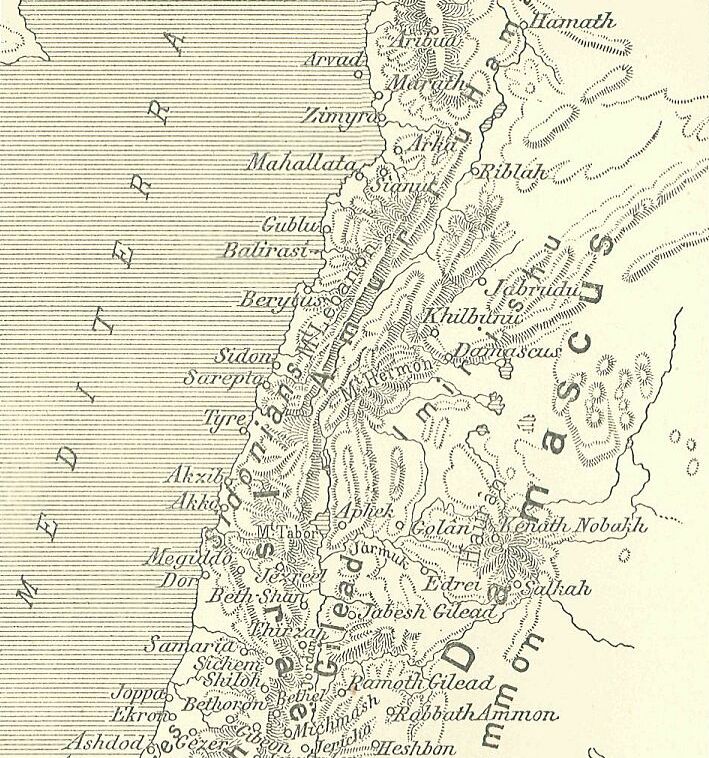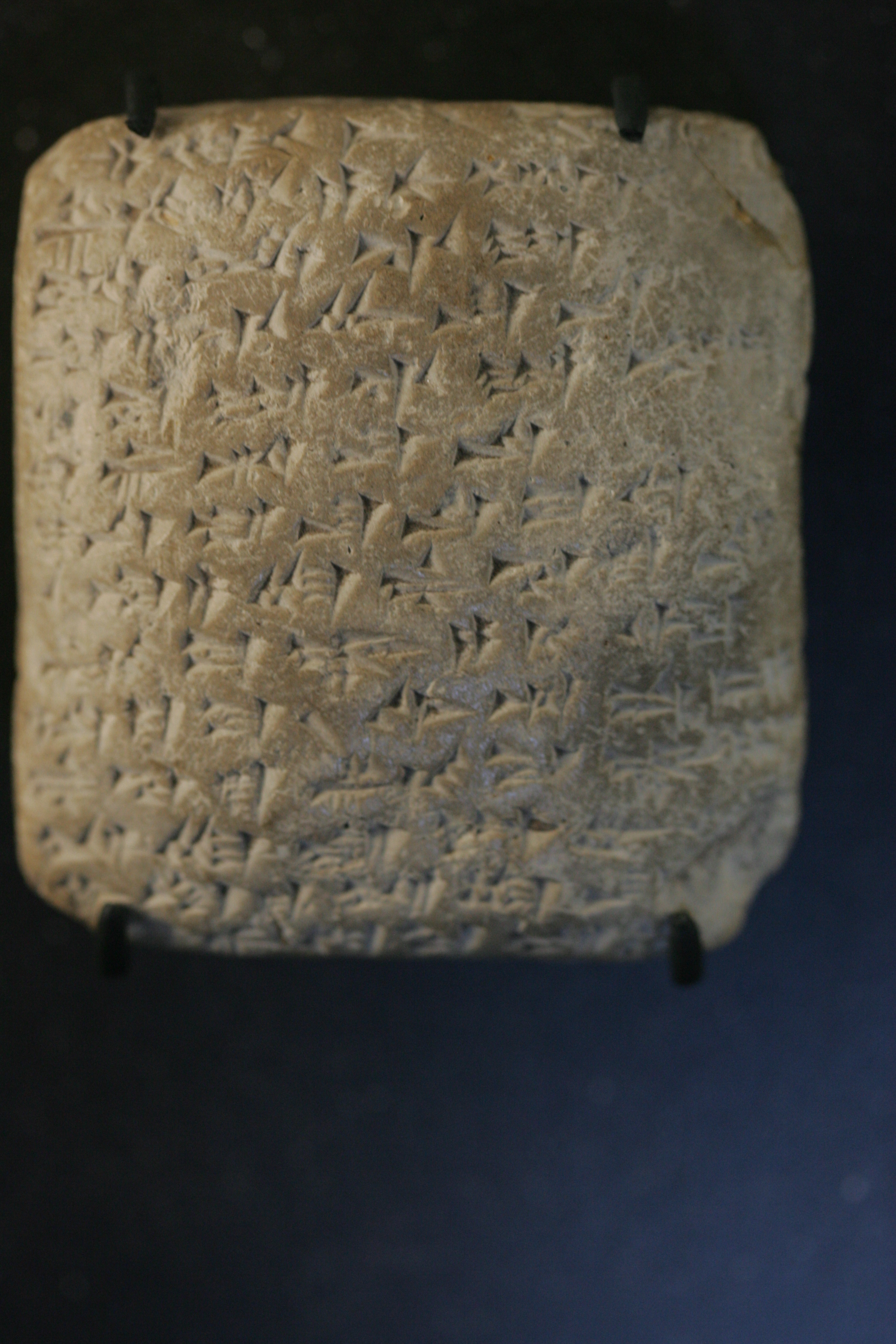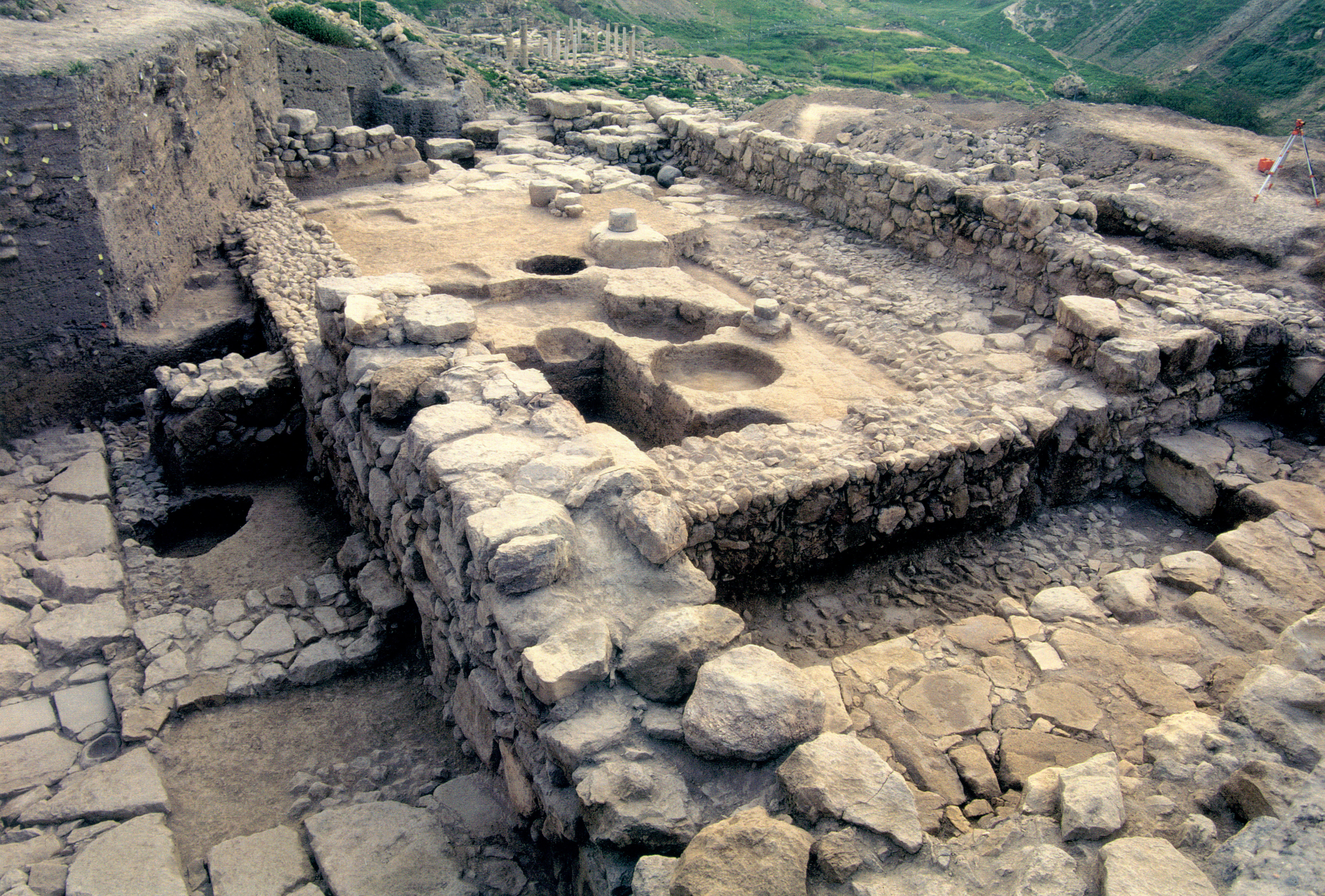|
Mutbaal
Mutbaal ( Akk. "man of Baal") was a Canaanite king of the Amarna Period. He is identified in the Amarna letters as a son of Labaya, the ruler of the hill country north of Jerusalem, including the territory in the vicinity of the city of Shachmu (biblical Shechem). Mutbaal may be the son whose association with the Habiru raiders Labaya denounced in EA 254. He ruled in Pella on the eastern side of the Jordan river. After his father's death at the hands of the citizens of Gina, Mutbaal and his brother continued their assaults on other Canaanite rulers and their holdings, employing Habiru mercenaries. Eventually Biryawaza of Damascus was ordered by the Egyptian court to take armed action against the sons of Labaya. (EA 250) List of Mutbaal's 2 letters to Pharaoh EA 255 Mutbaal letter no. 1 of 2, title: "No destination too far" Letter 255 by Mutbaal, about caravans, seems to imply that his location in western Jordan, (as "Mayor of Pihilu"-(modern Pella, Jordan)), was an important trad ... [...More Info...] [...Related Items...] OR: [Wikipedia] [Google] [Baidu] |
Labaya
Labaya (also transliterated as Labayu or Lib'ayu) was a 14th-century BCE ruler or warlord in the central hill country of southern Canaan. He lived contemporaneously with Pharaoh Akhenaten. Labaya is mentioned in several of the Amarna Letters (abbreviated "EA", for 'el Amarna'). He is the author of letters EA 252– 54. Labaya was active over the whole length of Samaria and slightly beyond, as he gave land to Habiru in the vicinity of Šakmu (Shechem) and he and his sons threatened such powerful towns as Jerusalem and Gazru (Gezer) to the south, and Megiddo to the north. Career The Amarna letters give an incomplete look at Labaya's career. In the first of Labaya's letters thus far discovered (EA 252), he defends himself to the Pharaoh against complaints of other city rulers about him, for example, the complaint that he has hired mercenaries from among the Habiru. Labaya further admitted to having invaded Gezer and insulting its king Milkilu. He denied any knowledge of his s ... [...More Info...] [...Related Items...] OR: [Wikipedia] [Google] [Baidu] |
David Rohl
The New Chronology is an alternative chronology of the ancient Near East developed by English Egyptologist David Rohl and other researchers beginning with ''A Test of Time: The Bible - from Myth to History'' in 1995. It contradicts mainstream Egyptology by proposing a major revision of the established Egyptian chronology, in particular by re-dating Egyptian kings of the Nineteenth through Twenty-fifth Dynasties, bringing forward conventional dating by up to 350 years. Rohl asserts that the New Chronology allows him to identify some of the characters in the Hebrew Bible with people whose names appear in archaeological finds. The New Chronology, one of several proposed radical revisions of the conventional chronology, has not been accepted in academic Egyptology, where the conventional chronology or small variations of it remains standard. Amélie Kuhrt, head of Ancient Near Eastern History at University College London, in one of the standard reference works of the discipline ... [...More Info...] [...Related Items...] OR: [Wikipedia] [Google] [Baidu] |
Amarna Letter EA 256
Amarna letter EA 256, in short EA 256, catalogued under the title ''Oaths and Denials'', is one of a total of about 350 so-called Amarna letters, belonging to an official correspondence dating to the mid-14th century BC (about 1350 BC till 20–25 years later). The initial corpus of letters were found at Akhenaten's city Akhetaten, on the floor of the Bureau of Correspondence of Pharaoh; others were later found, adding to the body of letters. Description EA 256 is a square, mostly flat clay tablet letter written on both sides; it is also written on the bottom, top (=bottom of ''reverse'' side), and the last 3 lines are written on the left edge (obverse), where the start of lines on the obverse form a 'straight' margin. The reverse of the letter (see Rohl), has a list of towns in, or associated with the Golan Heights. The surface of the letter is rough (partially eroded?), or photos of the reverse especially, do not easily highlight the cuneiform characters. The topic of the let ... [...More Info...] [...Related Items...] OR: [Wikipedia] [Google] [Baidu] |
Amarna Letters
The Amarna letters (; sometimes referred to as the Amarna correspondence or Amarna tablets, and cited with the abbreviation EA, for "El Amarna") are an archive, written on clay tablets, primarily consisting of diplomatic correspondence between the Ancient Egypt, Egyptian administration and its representatives in Canaan and Amurru kingdom, Amurru, or neighboring kingdom leaders, during the New Kingdom, spanning a period of no more than thirty years between c. 1360–1332 BC (see Amarna letters#Chronology, here for dates).Moran, p.xxxiv The letters were found in Upper Egypt at el-Amarna, the modern name for the ancient Egyptian capital of ''Akhetaten'', founded by pharaoh Akhenaten (1350s–1330s BC) during the Eighteenth Dynasty of Egypt. The Amarna letters are unusual in Egyptological research, because they are written not in the language of ancient Egypt, but in cuneiform, the writing system of ancient Mesopotamia. Most are in a variety of Akkadian language, Akkadian sometim ... [...More Info...] [...Related Items...] OR: [Wikipedia] [Google] [Baidu] |
Pella, Jordan
Pella ( gr, Πέλλα, ) was an ancient city in what is now northwest Jordan, containing ruins from the Neolithic, Chalcolithic,Bronze Age, Iron Age, Canaanite, Hellenistic and Islamic periods. It is located in a rich water source within the eastern foothills of the Jordan Valley, close to the modern village of Ṭabaqat Faḥl ( ar, طبقة فحل) some south of the Sea of Galilee (Lake Tiberias). The site is situated north of Amman: a drive of about an hour and a half (due to the difficult terrain), and an by car from Irbid, in the north of the country. Pella's ruins – predominantly temples, churches, and housing – have been partially excavated by teams of archaeologists; they attract thousands of tourists annually but especially in spring, during which time the area is awash with spring flowers. Name The Semitic name of the ancient, pre-Hellenistic site, was Pahil or Pihil. Pehal is the name under which the city is mentioned in early Egyptian (Bronze Age) historical ... [...More Info...] [...Related Items...] OR: [Wikipedia] [Google] [Baidu] |
Gina (Canaan)
Gina, mentioned in the Amarna Letters, was a town in ancient Canaan. The citizens of Gina were responsible for the death of Labaya. The town was later known as Beth-Hagan and was probably located roughly on the spot of the modern town of Jenin. Amarna letter Gina Amarna letter 250 records the only mention of Gina. It explains (in passing) the recent killing of Labaya, and the resultant of dealing with his two sons. An excerpt of the mostly complete 60-line letter: See also *Mutbaal Mutbaal ( Akk. "man of Baal") was a Canaanite king of the Amarna Period. He is identified in the Amarna letters as a son of Labaya, the ruler of the hill country north of Jerusalem, including the territory in the vicinity of the city of Shachmu (b ... References * Moran, William L. ''The Amarna Letters.'' Johns Hopkins University Press, 1987, 1992. (softcover, ) Canaanite cities Amarna letters locations Former populated places in Southwest Asia {{AncientNearEast-stub ... [...More Info...] [...Related Items...] OR: [Wikipedia] [Google] [Baidu] |
Akkadian Language
Akkadian (, Akkadian: )John Huehnergard & Christopher Woods, "Akkadian and Eblaite", ''The Cambridge Encyclopedia of the World's Ancient Languages''. Ed. Roger D. Woodard (2004, Cambridge) Pages 218-280 is an extinct East Semitic language that was spoken in ancient Mesopotamia ( Akkad, Assyria, Isin, Larsa and Babylonia) from the third millennium BC until its gradual replacement by Akkadian-influenced Old Aramaic among Mesopotamians by the 8th century BC. It is the earliest documented Semitic language. It used the cuneiform script, which was originally used to write the unrelated, and also extinct, Sumerian (which is a language isolate). Akkadian is named after the city of Akkad, a major centre of Mesopotamian civilization during the Akkadian Empire (c. 2334–2154 BC). The mutual influence between Sumerian and Akkadian had led scholars to describe the languages as a '' Sprachbund''. Akkadian proper names were first attested in Sumerian texts from around the mid 3rd-mi ... [...More Info...] [...Related Items...] OR: [Wikipedia] [Google] [Baidu] |
Jonathan (1 Samuel)
Jonathan (Hebrew: ''Yəhōnāṯān'' or ''Yōnāṯān''; "Yahweh has gifted") is a heroic figure in 1 Samuel in the Hebrew Bible. A prince of the United Kingdom of Israel, he was the eldest son of King Saul as well as a close friend of David, who eventually succeeded Saul as king. Like his father, he was a man of great strength and swiftness2 Samuel 1:23, and he excelled in archery (2 Samuel 1:22 and slinging. Conflicts with Saul Jonathan first appears in the biblical narrative as the victor of Geba, a Philistine stronghold (1 Samuel 13), while in the following chapter he carries out a lone and secret attack on another Philistine garrison, demonstrating his "prowess and courage as a warrior."T. H. Jones, "Jonathan," in J. D. Douglas, (ed.), ''New Bible Dictionary'' (Grand Rapids: Eerdmans, 1965), 654. However, he eats honey without knowing that his father had said, "Cursed be any man who eats food before evening comes" (1 Samuel 14:24). When he learns of his father's ... [...More Info...] [...Related Items...] OR: [Wikipedia] [Google] [Baidu] |
King Saul
Saul (; he, , ; , ; ) was, according to the Hebrew Bible, the first monarch of the United Kingdom of Israel. His reign, traditionally placed in the late 11th century BCE, supposedly marked the transition of Israel and Judah from a scattered tribal society to organized statehood. The historicity of Saul and the United Kingdom of Israel is not universally accepted, as what is known of both comes from the Hebrew Bible. According to the text, he was anointed as king of the Israelites by Samuel, and reigned from Gibeah. Saul is said to have died by suicide when he "fell on his sword" during a battle with the Philistines at Mount Gilboa, in which three of his sons were also killed. The succession to his throne was contested between Ish-bosheth, his only surviving son, and David, his son-in-law; David ultimately prevailed and assumed kingship over Israel and Judah. Biblical account The biblical accounts of Saul's life are found in the Books of Samuel: House of King Saul According ... [...More Info...] [...Related Items...] OR: [Wikipedia] [Google] [Baidu] |
Israelite
The Israelites (; , , ) were a group of Semitic-speaking tribes in the ancient Near East who, during the Iron Age, inhabited a part of Canaan. The earliest recorded evidence of a people by the name of Israel appears in the Merneptah Stele of ancient Egypt, dated to about 1200 BCE. According to the modern archaeological account, the Israelites and their culture branched out of the Canaanite peoples and their cultures through the development of a distinct monolatristic—and later monotheistic—religion centred on the national god Yahweh.Mark Smith in "The Early History of God: Yahweh and Other Deities of Ancient Israel" states "Despite the long regnant model that the Canaanites and Israelites were people of fundamentally different culture, archaeological data now casts doubt on this view. The material culture of the region exhibits numerous common points between Israelites and Canaanites in the Iron I period (c. 1200–1000 BCE). The record would suggest that the Isra ... [...More Info...] [...Related Items...] OR: [Wikipedia] [Google] [Baidu] |
Ishbaal
Ish-bosheth ( he, , translit=ʼĪš-bōšeṯ, "man of shame"), also called Eshbaal (, ; alternatively spelled Ishbaal, "fire of Baal") was, according to the Hebrew Bible, the second monarch of the Kingdom of Israel who succeeded his father, Saul. He reigned for two years, during which he was at war with David. He was killed by two of his own army captains. Biblical narrative In the biblical account, Abner, the captain of Saul's army, proclaimed Ish-bosheth king over Israel at Mahanaim in Transjordan (), after the slaying of Ish-bosheth's father and brothers in the battle of Gilboa (). Ish-bosheth was 40 years old at this time and reigned for two years (). However, after the death of King Saul, the tribe of Judah seceded from the rule of the House of Saul by proclaiming David as its king (), and war ensued (). David's faction eventually prevailed against Ish-bosheth's (), but the war continued until Abner joined David (). Before the death of Saul, David had been married to ... [...More Info...] [...Related Items...] OR: [Wikipedia] [Google] [Baidu] |
Joab
Joab (Hebrew Modern: ''Yōʼav'', Tiberian: ''Yōʼāḇ'') the son of Zeruiah, was the nephew of King David and the commander of his army, according to the Hebrew Bible. Name The name Joab is, like many other Hebrew names, theophoric - derived from YHVH (), the name of the God of Israel, and the Hebrew word 'av' (), meaning 'father'. It therefore means 'YHVH sfather'. Life Joab was the son of Zeruiah, a sister of king David (1 Chronicles 2:15-16). According to Josephus (Antiquities VII, 1, 3) his father was called Suri.Flavius Josephus, ''Antiquities of the Jews''Book VII, Chapter 1, 3 Joab had two brothers, Abishai and Asahel. Asahel was killed by Abner in combat, for which Joab took revenge by murdering Abner against David's wishes and shortly after David and Abner had secured peace between the House of David and the House of Saul (2 Samuel 2:13-3:21; 3:27). While 2 Samuel 3:27 explicitly states that Joab killed Abner "to avenge the blood of his brother Asahel", Jo ... [...More Info...] [...Related Items...] OR: [Wikipedia] [Google] [Baidu] |









